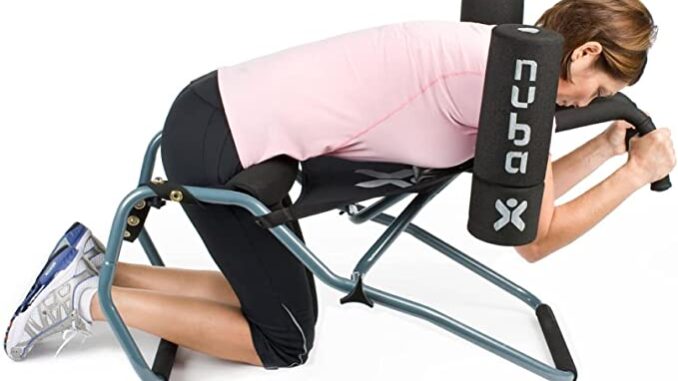
Traction therapy is a technique used to alleviate back pain by gently stretching the spine. Traction can be performed at home using a few different methods. However, before attempting any traction therapy, it is important to consult with your doctor or physical therapist to ensure it is safe for your specific condition. Here are some general steps for performing traction therapy for the back at home:
- Lie down on a firm surface, such as a yoga mat or carpet, and place a small pillow or rolled towel under your head for support.
- Using an over-the-door cervical traction kit or similar device, attach the traction harness to the top of the door and place the neck brace around your neck, making sure it is snug but comfortable.
- Adjust the length of the rope so that the traction device is pulling gently on your neck, causing a slight stretch in your spine. Be sure to follow the manufacturer’s instructions and not exceed the recommended amount of weight or duration of the stretch.
- Relax and hold the stretch for the recommended time period, usually 10-20 minutes.
- Once the recommended duration has passed, gently release the traction device and slowly remove the neck brace.
- Take a few minutes to rest and stretch your neck and back muscles before getting up.
It is important to note that traction therapy may not be appropriate for everyone, and it is best to consult with a medical professional before attempting this therapy at home. Additionally, it is important to follow the instructions for the specific traction device being used e.g Nubax Trio, as different devices may have different requirements for use.
How Nubax Trio Can Help In Traction For Back At Home
The Nubax Trio is a type of traction device that is designed to help relieve back pain by gently stretching the spine. The device is compact and portable, making it a convenient option for use at home.
Here’s how the Nubax Trio can help in traction for the back at home:
- The Nubax Trio uses a unique method of spinal decompression to help relieve pressure on the lower back. By supporting the hips and waist while the user leans forward, the device creates a traction force that helps stretch the spine and relieve pressure on the intervertebral discs.
- The Nubax Trio is adjustable, so users can control the amount of traction force applied to the spine. This makes it a safe and effective option for people with different levels of back pain and spinal conditions.
- The Nubax Trio is easy to use and can be set up quickly in any room of the house. Users can perform a quick traction session at home, without needing to schedule appointments or travel to a physical therapy clinic.
- Unlike other traction devices, the Nubax Trio does not require any external attachments or weights. The device relies solely on the user’s body weight to create the traction force, making it a more convenient and user-friendly option.
- The Nubax Trio is a cost-effective alternative to other types of traction therapy. Rather than paying for expensive treatments or devices, users can purchase the Nubax Trio once and use it at home as often as needed.
Overall, the Nubax Trio can be an effective and convenient option for performing traction for the back at home. However, as with any medical device or treatment, it is important to consult with a medical professional before using the Nubax Trio, especially if you have any pre-existing medical conditions or concerns.
Is Traction Therapy Safe in Pregnancy
Traction therapy for the back may not be appropriate for pregnant women, as it may cause undue stress on the lower back and abdomen. Additionally, there is limited research on the safety and effectiveness of traction therapy during pregnancy, so it is important to consult with a healthcare provider before attempting any form of traction therapy.
Important Points for Traction Therapy If you are pregnant
If your healthcare provider determines that traction therapy is safe for you during pregnancy, they may recommend using a special type of traction device that is specifically designed for pregnant women that too in the early pregnancy stage. These devices typically provide support to the back and abdomen while allowing for gentle stretching of the spine.
Here are some general guidelines for performing traction therapy for the back at home during pregnancy:
- Choose a device that is specifically designed for pregnant women, and follow the manufacturer’s instructions carefully.
- Avoid over-stretching the spine, as this may cause discomfort or strain on the lower back and abdomen. Only stretch to the point of mild tension, and avoid any positions or movements that cause pain.
- Always have a support person present when performing traction therapy at home, in case you need assistance or experience any discomfort.
- Stay hydrated and take breaks as needed. It is important to listen to your body and rest if you feel fatigued or uncomfortable.
- If you experience any unusual symptoms or discomfort during traction therapy, stop immediately and consult with your healthcare provider.
Remember, it is important to consult with a healthcare provider before attempting any form of traction therapy during pregnancy. They can help determine if traction therapy is safe for you, and provide guidance on how to perform the therapy safely and effectively.
Leave a Reply